Text
Could Viruses be the Answer to Preventing Harmful Algal Blooms?
A harmful bloom-forming alga called Heterocapsa circularisquama caused an oyster farm in Japan to lose approximately $2 million US dollars. H. circularisquama produces toxins that are harmful to bivalves such as oysters and when a bloom formed in Lake Kamo, Japan there was a mass mortality of oysters, resulting in economic loss. Fisheries worldwide are experiencing economic strain due to HABs but more importantly, HABs are threatening global food security and they’re destroying ecosystems. Because of this, now more than ever it is crucial that we find ways to control HABs to reduce their negative impacts – which is a daunting task because, in the process of controlling HABs we also need to ensure that we are not causing secondary effects on other organisms.
There are chemical, biological and mechanical methods for controlling HABs that have been tested in laboratory settings but they have setbacks. They tend to be difficult to apply to real worlds scenarios due to logistics, high costs and the negative impacts they have on the environment. When Lake Kamo experienced its first H. circularisquama bloom, scientist Nakayama and his team began to brainstorm other possible mechanisms that they could use to prevent future blooms in hopes to reduce oyster fatality and subsequent economic loss. Due to the constraints of the previously mentioned HAB control mechanisms, they wanted to see if they could use viruses as a means of controlling H. circularisquama blooms in Lake Kamo. I know what you’re thinking – viruses? Wouldn’t that affect the entire ecosystem and be dangerous for many of the organisms living in the same habitat? Actually no. Viruses can be very host specific which means that they are only harmful to certain organisms and not others. The researchers knew about a virus called HcRNAV which is a virus that only infects H. circularisquama. Therefore, they hypothesized that adding HcRNAV to H. circularisquama blooms would reduce the blooms ability to grow and persist which would reduce oyster fatality and economic strain. With this idea in mind, they went to the laboratory to test it.
The researchers had three different treatment groups to test how HcRNAV would impact the growth of H. circularisquama. The first treatment group was a culture of H. circularisquama at ~500cells/ml that was inoculated with HcRNAV. The second treatment group was a culture of H. circularisquama at ~5000cells/ml that was inoculated with HcRNAV, and the final group was the control group which was not exposed to any virus. The researchers observed the growth of H. circularisquama in each group over a period of 6 days and using laboratory techniques, they calculated and plotted the cell densities and the virus titer. Virus titer is the concentration of infectious viral particles in the given sample. They successfully observed that by day 6, both treatment groups had significantly less cell density than the control and higher virus titer indicating that HcRNAV suppressed H. circularisquama growth and is a strong candidate for controlling HABs.
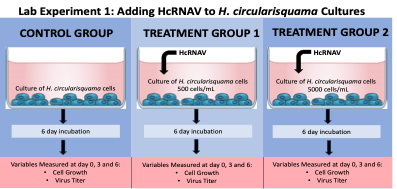
Figure 1. H. circularisquama cultures were exposed to HcRNAV over a period of 6 days and their growth and virus titer were measured and compared to the control group. By day 6 both of the treatment groups had less cell growth and increased virus titer.
The next step to test the efficacy of HcRNAV in reducing H. circularisquama blooms is to conduct a field experiment in a small, contained section in Lake Kamo. There was one major problem though – the community members were not convinced that this experiment was safe due to the use of viruses and refused to allow the researchers to conduct the experiment in Lake Kamo, halting their progress.
Luckily, thanks to previous studies the researchers understood the cycle of HcRNAV which is as follows: When Lake conditions allow for the rapid growth of H. circularisquama, HcRNAV will rapidly spread through the H. circularisquama population and then, as the bloom enters a declining phase and many of the H. circularisquama die, the virus has fewer hosts to infect and HcRNAV accumulates in bottom sediments. Understanding this pattern allowed them to hypothesize that sediment from the bottom of the lake would contain HcRNAV and therefore, adding natural sediment from Lake Kamo to H. circularisquama blooms could reduce its growth.
To test this, the researchers did another lab experiment where they collected sediment from Lake Kamo and added it to cultures of H. circularisquama and measured cell growth and virus titer over a period of five days. In the first treatment group they added 1g/L of sediment to H. circularisquama cultures, in the second treatment group they added a higher concentration of sediment (10g/L) to H. circularisquama cultures and the third treatment group was the control. The results were promising. By day 3 there was a significant decrease in cell growth in both treatment groups compared to the control and by day 6 this difference intensified. Furthermore, after adding the sediment, the virus titer increased over time which shows that only a small amount of sediment is required to achieve a decrease in cell growth because once the virus is present in the population, HcRNAV will multiply reducing the need for repeat doses. These results suggest that the sediment containing HcRNAV was successful at reducing the growth of H. circularisquama which means that it will likely help reduce the negative impacts H. circularisquama has on oyster farming in Lake Kamo.
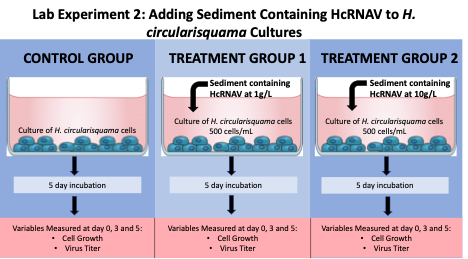
Figure 2. H. circularisquama cultures were exposed to sediment containing HcRNAV over a period of 5 days and their growth and virus titer were measured and compared to the control group. By day 5 both of the treatment groups had less cell growth and increased virus titer.
It was easier to obtain social support from the community when proposing to use natural sediment containing virus rather than adding artificially produced viruses. The researchers were granted permission to conduct a controlled field experiment in Lake Kamo – the first field test of viral control of HABs worldwide! For this experiment they set up two mesocosms which is a fancy way of saying that their set up occurred in the natural outdoor environment under controlled conditions which were attained by using a floating ‘caged’ system. The first ‘cage’ was the control and the second ‘cage’ was the treatment group in which they added ~1.4kg of sediment that was mixed with 50L of bloom water. They conducted the experiment during a bloom event when the concentration of H. circularisquama was approximately 3000 cell/mL in each mesocosm. Similar to the laboratory experiment, they calculated cell growth and virus titer over a period of 5 days and found that by day 3 the growth of H. circularisquama in the treatment group was significantly lower than the control group. This trend continued in day 4 and day 5. They also observed that the virus titer was higher in the treatment group until day 5 where it dropped drastically due to the decrease in H. circularisquama hosts required for HcRNAV survival. These results show that HcRNAV is a good candidate for speeding up the decline of H. circularisquama blooms which would reduce their harmful effects on oyster farms.
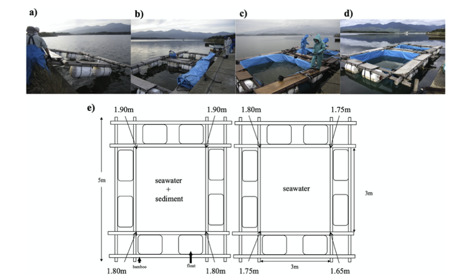
Figure 3. Mesocosms created in Lake Kamo Japan during a H. circularisquama bloom. The treatment mesocosm was exposed to sediment containing HcRNAV over a period of 5 days and their growth and virus titer were measured and compared to the control group. By day 5 both of the treatment groups had less cell growth. Photo taken from Nakayama, et al. (2020).
These results are promising for the potential to control HABs using viruses however, there are some important considerations before implementing this strategy. First, viruses undergo mutations rapidly and influencing host-virus relationships by adding sediment containing viruses could potentially increase their mutation rate. This is concerning because it is impossible to know how the mutations are going to affect viral mechanisms and can potentially be harmful. Also, the variability in the host response is something to consider. The increase in viral-host interactions could cause the host to alter its behaviour in response to the virus and we are unable to predict these potential variabilities or their effects. Regardless, this study presents an effective, eco-friendly, and low-cost mechanism for controlling HABs and could be revolutionary for fisheries that have experienced severe economic loss due to HABs and should be further studied.
For more information check out the link below!
Evaluation of a virus-based control method to protect cultured oysters from the harmful dinoflagellate Heterocapsa circularisquama
Cheers, Shyanne
1 note
·
View note
Text
Marine Snow – A Potential Solution to Climate Change
Did you know that it snows underwater in the ocean? This phenomenon is called marine snow which is made primarily of diatoms, polysaccharides, minerals and other materials. These materials clump together becoming heavy enough to sink to the ocean floor, giving the appearance of snow. Marine snow has a superpower – as it sinks to the ocean floor it brings carbon with it, trapping carbon for millennia which reduces atmospheric carbon, a potent greenhouse gas. We have known about the important role diatoms play in carbon sequestration for a while however, how polysaccharides, which act as glue to bind molecules together to form marine snow, evade degradation remains unknown. A recent discovery of a stable and sticky polysaccharide has given us insight on how this process works and is a potential candidate for contributing to carbon sequestration and thus, a way to reduce the effects of climate change.
Diatoms are algae that can participate in algal blooms. These blooms consist of many organisms, including bacteria, which can produce enzymes that function to destroy polysaccharides. It takes approximately 10 days for marine snow to sink to the bottom of the ocean floor and during that time, it must resist degradation by the enzymes that are highly abundant during bloom events. Researchers set out to identify a polysaccharide present in diatom blooms that is stable and is able to promote aggregation of molecules that form marine snow, to better understand how marine snow is able to survive the trip to the bottom of the ocean floor. They used monoclonal antibodies (mAb) to detect polysaccharides present in the blooms because mAbs are highly selective and have high affinity for specific polysaccharides. That means that mAbs can detect specific polysaccharides in samples that contain complex marine organic matter.
The detection of a polysaccharide called fucose-containing sulphated polysaccharide (FCSP) peaked the researcher’s interest due to its ability to accumulate during blooms and persist for weeks to months. This observation suggests that FCSP is stable and not easily degraded, indicating that it could be resistant to degradation and keep marine snow intact while it journeys to the ocean floor. Furthermore, the researchers discovered that FCSP was capable of aggregation, another property that suggests it plays an important role in the formation and protection of marine snow. The discovery of FCSP production in diatom blooms is exciting because it unveils a previously uncharacterized polysaccharide that contributes to marine snow formation and potentially to carbon sequestration in the ocean! The more we know about natural carbon sequestration methods, the better equipped we are to find solutions to our current climate crisis.
For more information, click the link below! https://www.nature.com/articles/s41467-021-21009-6
Cheers,
Shyanne
2 notes
·
View notes
Photo
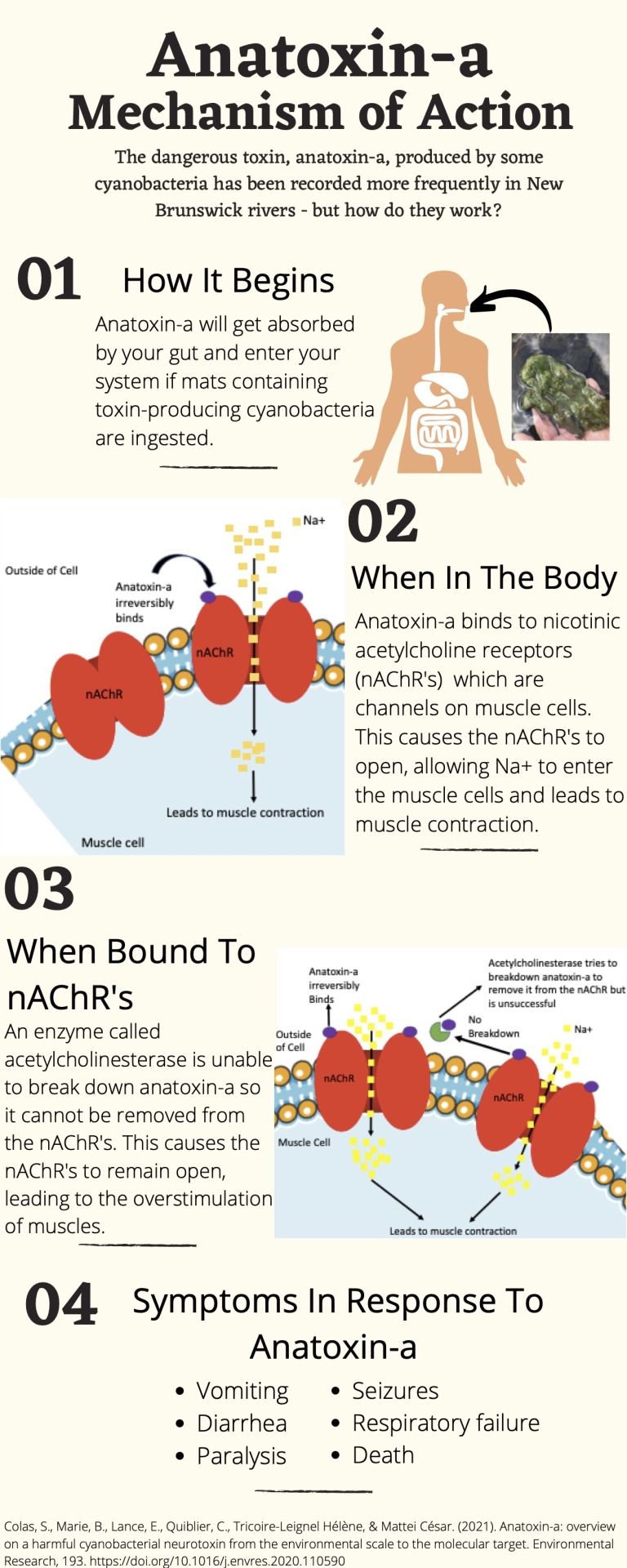
A quick summary of the mechanism of action of the cyanotoxin, anatoxin-a. This toxin is produced by some cyanobacteria inhabiting the Wolastoq river in Fredericton N.B and can be very harmful when ingested.
1 note
·
View note
Text
Anatoxin-a – The Deadly Toxin: Could it Actually be Beneficial?
Death by suffocation. One of most terrifying ways to die. Yet this was a reality for three dogs following what seemed to be a nice walk along the Wolastoq river (St. John River) in 2018 (McCarron et al., 2018). These dogs were otherwise healthy before going for a walk with their respective owners by the river, but upon ingesting toxic mats of vegetation that had washed up on the shore, they died within minutes. The toxin responsible for their death is called anatoxin -a which is produced by some cyanobacteria, commonly known as blue-green algae. Anatoxin-a is a dangerous toxin when ingested, but killing dogs is likely not its primary function. So, why do cyanobacteria possess the ability to synthesize this toxin and what ecological roles does anatoxin-a play?
There are many genera of cyanobacteria that are capable of producing anatoxin-a including, Phormidium, Kamptonema, Microcoleus, Oscillatoria however, not all species within these genera can produce anatoxin-a. Cyanobacteria must have the anatoxin-a gene cluster which contains 10 genes (anaA-J) that are all needed for anatoxin-a production. Because these genes are present in multiple genera of cyanobacteria, it is likely that producing anatoxin-a provides cyanobacteria with some advantage, otherwise the genes would have been removed from the population by natural selection.
Cyanobacteria that have the genes required to synthesize anatoxin-a are not constantly producing the toxin. This would be disadvantageous because the organism would be expending a lot of energy into making anatoxin-a when it doesn’t need to. Therefore, there must be some stimulus that triggers the cyanobacteria to turn on the genes required to make anatoxin-a. The stimulus that promotes the production of anatoxin-a is still a mystery however, scientists hypothesize that cyanobacteria may use anatoxin-a as a way to prevent other organisms from stealing their nutrients and growing which would beneficial for cyanobacteria. In other words, scientist want to know if anatoxin-a asks as a weapon to destroy other microscopic organisms so that cyanobacteria do not have to compete for food and energy.
Cyanobacteria can form blooms which contain high densities of a variety of different types of toxic and non-toxic cyanobacteria as well as other microscopic organisms all living in a community, using the same pool of nutrients. This type of habitat is very competitive and all the organisms are competing for food and light to survive. If anatoxin-a could destroy other organisms in this habitat, it would reduce the competition for cyanobacteria allowing them to grow more efficiently. One of the microscopic organisms that can be found living in these blooms is a type of green algae called Selenastrum capricornutum. Scientists from Ahmadu Bello University tested how cultures of this green algae were affected by anatoxin-a exposure to try to uncover a potential ecological role of anatoxin-a (Figure 1).
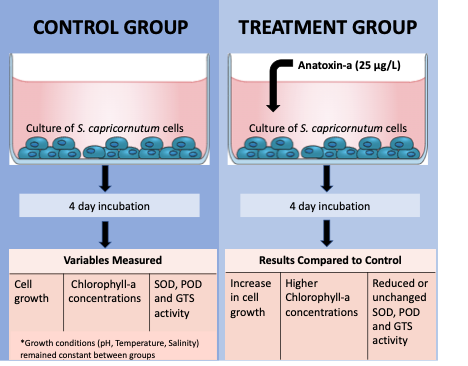
Figure 1. S. capricornutum cultures were exposed to anatoxin-a over a period of 4 days and their growth, chlorophyll-a concentrations, and stress response were measured and compared to the control group. S. capricornutum cultures exposed to anatoxin-a had increase cell growth, higher chlorophyll concentrations and reduced stress level indicating that anatoxin-a exposure benefited S. capricornutum.
Unexpectedly, when cultures of S. capricornutum were exposed to anatoxin-a over a period of four days the cultures grew better than the control group (Figure 1). This means that S. capricornutum benefited from anatoxin-a and does not support the idea that cyanobacteria produce anatoxin-a to prevent the growth of other organisms. This discovery leads to the question: how is anatoxin-a causing an increase in growth of S. capricornutum?
To answer this, the levels of chlorophyll-a were measured. Chlorophyll-a is a pigment that plays a role in absorbing sunlight which improves photosynthesis and can be an indication that the cells are healthy. The results showed that S. capricornutum cultures exposed to anatoxin-a had higher levels of chlorophyll-a than those that were not exposed to anatoxin-a. Studies have shown that S. capricornutum can break down anatoxin-a and use its molecular components to supplement photosynthetic C acquisition. Therefore, the presence of anatoxin-a would be beneficial for S. capricornutum when competing for light in a crowded bloom and can help explain the increased levels of chlorophyll-a. These findings suggest that anatoxin-a improved the health of S. capricornutum cultures and helped the cells grow and survive!
Toxins are generally harmful and cause organisms to experience a stress response. When this occurs reactive oxygen species (ROS) are produced at higher rates. Although ROS are a naturally produced, they can cause a lot of damage to the cell and can lead to death. If cells are stressed and producing ROS at high rates, the cells will turn on genes to produce proteins that function to stop ROS from damaging the cell. The ROS-destroying proteins that get produced to protect the cell include: peroxidase (POD), superoxide dismutase (SOD), and glutathione S-transferase (GST). If high concentrations of POD, SOD and GST are found in a cell, it indicates that ROS are being produced, suggesting that the cell is experiencing stress. When S. capricornutum was exposed to anatoxin-a, the amount of POD, SOD, and GST present in the cell either remained the same or decreased compared to the controls which implies that S. capricornutum is under less stress when anatoxin-a is present. Because S. capricornutum isn’t wasting energy producing these proteins to prevent cell damage, it can dedicate more energy into growing which explains why it grows better in the presence of anatoxin-a.
Although the results were not as expected, we still learned more about anatoxin-a’s role in its environment: it improves the health and growth of the green algae, S. capricornutum. This debunks the hypothesis that cyanobacteria produce toxin to inhibit the growth of other organisms however, S. capricornutum is only one organism of many that are present in blooms and we cannot assume that anatoxin-a will benefit all microorganism living in the community. More studies need to be done to see how other types or bacteria and microbes respond to anatoxin-a. We are still unsure how the production of anatoxin-a benefits cyanobacteria but we do know that it helps S. capricornutum grow, which means that the presence of anatoxin-a has the ability to shape and influence microscopic community compositions.
For more detailed information about anatoxin-a’s influence on S. capricornutum click the link below.
The Individual and Combined Effects of the Cyanotoxins, Anatoxin-a and Microcystin-LR, on the Growth, Toxin Production, and Nitrogen Fixation of Prokaryotic and Eukaryotic Algae
Until next time my fellow biology lovers,
Shyanne
2 notes
·
View notes
Text
Biohazard to Biomaterial: Turning Dangerous Algal Blooms into Biomaterials as an Environmentally Safe Alternative to Plastics.
Sustainability. A hot topic in today’s business world. Companies are actively searching for ways to meet costumers’ desires to become more bio-conscious. Ryan Hunt, a physic and bioengineer graduate from the University of Georgia and founder of the company Algix is doing just that.
Algix is a company that recognizes the threat that algal blooms pose on aquatic ecosystems, and our economy and set out to find ways to clean up these harmful blooms and use them to make sustainable materials.
Algix is changing the way we view algal blooms – using them as a resource to make materials used in shoes, yoga mats and surf boards. Algix sources algae from natural waters experiencing blooms by using biotechnology which filters the water to remove the harmful algae for later use. Not only does this help protect aquatic ecosystems but also, the production of the material has a significantly smaller carbon footprint, uses less water and requires less energy. Algix has found a way to conquer two issues – sustainable fashion and an eco-friendly solution to our global algal bloom crisis.
Partnered with large companies such as Adidas, H&M, New balance and more – Algix is working to revolutionize they way we view fashion, nature and environmental crises.
Want to learn more? Check out the following magazine article or listen to the podcast linked below. Both highlight Ryan Hunts efforts to create sustainable fashion while cleaning up aquatic ecosystems!
Magazine: Harmful Algae Blooms: An untapped resource.
Podcast: GREEN PRODUCT & SUPPLY CHAIN: How to sell an eco-innovative product to Adidas, with Ryan Hunt (Algix).
1 note
·
View note
Text
Harmful Algal Blooms: Where There is Adventure There is Water
Adventurous. If there was one word that could describe me best, it's that.
During winter, I enjoy ice climbing, skating, snowshoeing, and any other outdoor activity that sparks adrenalin. In summer, you can find me rock climbing, paddle boarding, canoeing, bridge jumping, and hiking along with any other activity I'm lucky enough to participate in.
If it's adventurous, I'm in!

Take a second and consider what the above summer activities have in common. Any ideas? The answer I'm looking for isn't very obvious: they all require a water source either for hydration or for the activity itself. When I am hiking, climbing or camping I rely on rivers and streams as a source of drinking water. When I'm on a canoe trip or cliff jumping the activity occurs in a body of water. Therefore, water quality is something I care about and stay informed on as it greatly impacts my adventurous lifestyle.
In recent years there has been rising concern among the scientific community and public health regarding water quality due to the increasing prevalence of harmful algal blooms, also known as HABs. In this blog, I am going to provide information regarding HABs in hopes that people will have a better understanding of the importance of studying HABs and the affects they have on ecosystems and our communities.
This topic is important for anyone who enjoys recreating in water, public health policy makers, community. leaders and fisheries. It is essential that we improve our understanding of HABs - how to predict them to warn the public, how to prevent them to keep our drinking water safe and to reduce mass mortality of fish and bivalves, and how to protect the ecosystems they invade.
So, what are HABs and why are they harmful?
Essentially, a HAB is rapid growth of algal species in a body of water under favourable conditions. There are different kinds of blooms and different species that can participate in blooms including, dinoflagellates, diatoms, members of the SAR super group and cyanobacteria which unlike the other examples is a prokaryotic organism.
Why are HABs of concern?
1. They use up all the oxygen in the water which means that other animals and plants that require oxygen cannot get it
2. They can produce toxins that can harm or kill animals and even humans
3. They are a concern for public health because they are affecting water quality
Follow along as I teach and learn all about harmful algal blooms and the methods we are using to try to detect them and prevent them. We will talk about different types of blooms, impacts of climate change, and HABs affecting our local Fredericton community as well as other current news on this expanding topic.
Thanks for joining me on this adventure,
Shyanne
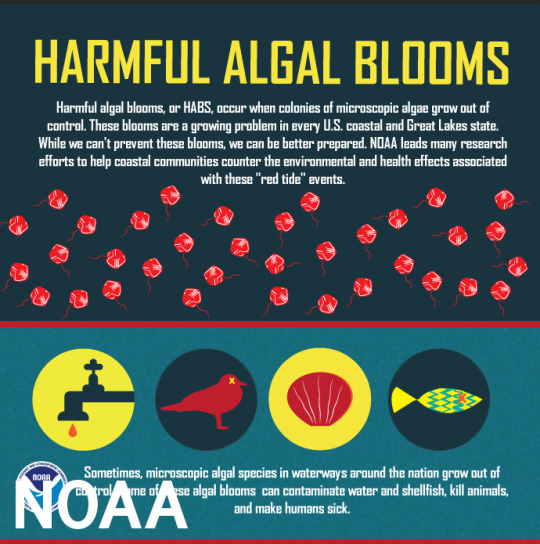
https://www.noaa.gov/what-is-harmful-algal-bloom
4 notes
·
View notes